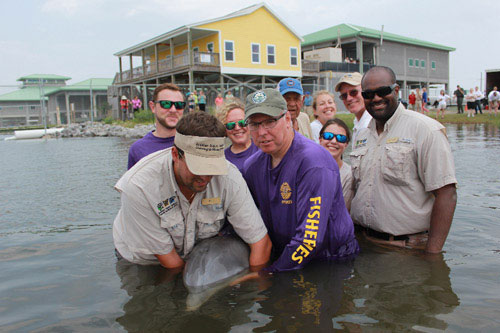
‘Octavius’ swam into Barataria Bay on Thursday, LDWF says
The first dolphin ever to be rescued from a Louisiana beach and then successfully rehabilitated was released into Barataria Bay on Thursday, according to a news release.
“This is a truly notable event,” Mandy Tumlin, the stranding coordinator for marine mammals and sea turtles with the Louisiana Department of Wildlife and Fisheries, said in the release. “Dolphins can be deemed non-releasable for a variety of reasons, such as a medical condition that may hinder their ability to survive.”
On Oct. 26, 2015, biologists from LDWF responded to a report by a private citizen of a live, stranded dolphin on Grand Isle Beach. Based on initial evaluations, the 6 ½-foot-long juvenile dolphin was responsive. High water and rough seas associated with Hurricane Patricia likely contributed to the cause of the stranding.
“It’s unknown how long the animal was on the beach before he was discovered, but that period of time was a definite strain on him,” Tumlin said. “Dolphins are accustomed to buoyancy when in the water, so there is significant strain on their muscles when the animal is stranded and take on their entire body weight.”
Biologists attempted to release the animal then, but ended up transporting it to the Freeport-McMoran Audubon Species Survival Center in New Orleans for treatment. Named Octavius for the Audubon vet caring for it, the dolphin responded well to treatment and was able to swim on its own.
Throughout its stay in New Orleans, it never became desensitized to humans, an important step for its eventual release.
“Animals can often become dependent on humans for food and other resources following time in rehabilitative care,” Tumlin said. “Dolphins are very intelligent animals. Over time, they can learn to associate humans and boats as a source for food, which is why it is illegal to feed them in the wild.”
The dolphin, estimated to be about 3 years old (although it could be as young as 1 and as old as 7) ultimately passed a battery of tests and was declared a “conditionally releasable” animal. A tag on its dorsal fin will allow biologists to monitor its progress in real time.
“The tag allows for satellite tracking as well as radio tracking,” Tumlin said. “Since he could be a younger animal, this type of monitoring is necessary to ensure he is thriving back in the wild.”
LDWF leads the response for sea turtles and marine mammal strandings, and Audubon Nature Institute works closely with the department as a response partner to collect data about existing populations of animals along Louisiana’s coast and waterways and to assist and support researchers in the conservation of marine species.
“We are particularly grateful to the public who continually assist us with our recovery efforts by reporting these strandings to our department,” LDWF Secretary Charlie Melancon said. “Robert Shannon, the individual who first discovered the dolphin lying beached on its side, likely saved this animal’s life.”


